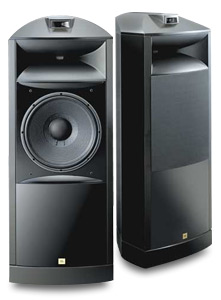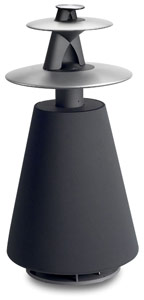 |
|
| September 15, 2003 Sound and Music: Dispersion, Distribution, and Directivity The topic of sound dispersion doesn’t sound particularly exciting. In the world of domestic hi-fi, however, dispersion (distribution and directivity are alternative terms with more or less the same meaning) is probably the single most important factor that distinguishes between the alternative approaches of rival speaker brands. The crucial point is that the sound we hear from a pair of speakers is a mixture of the soundwaves that travel directly from the speakers to the listeners, and those that arrive after reflecting off the main surfaces of the room. (A third set of soundwaves is primarily a product of the way the low-frequency modes of the listening room are excited, but that will have to wait till next month.) The character of a loudspeaker is not, therefore, determined by the direct sound alone, but by a combination of direct and reflected sounds. This poses the speaker designer the dilemma of deciding how much sound energy should be directed forward to reach the listeners directly, and how much should arrive after being reflected. Basically, when a driver diaphragm is physically smaller than the wavelength of the sound it’s reproducing -- which, at low frequencies, it invariably will be -- the sound is radiated in every direction, similar to the way light comes from a lightbulb. When the driver diaphragm is larger than the wavelength, which is likely to occur in the midband and treble, the sound is projected forward more like a flashlight or headlamp. In practice, the transition between the two states is quite gradual, and will be modified by the size of the baffle on which the driver is mounted. The control of dispersion has much to do with balancing these variables. The best way to explain the implications of these different types of sound dispersion is to look at some examples from opposite ends of the speaker spectrum. At one extreme are "omnidirectional" designs, which deliberately spread the sound in every direction, ensuring that most of what the listener hears has been reflected en route. Although it takes a unique approach, a classic example of an omnidirectional speaker is the Bose 901, the basic design of which has been around for nearly 40 years. The Bose 901 has nine identical full-range 4.5" drivers, all operating in unison, and an electronic pre-equalizer to achieve a neutral balance. Of those nine drivers, only one faces forward toward the listener; the other eight cover the rear panel, which is shaped like a broad V, so that their output bounces off the rear and side walls. This means that only about 10% of the 901’s output travels directly to the listeners’ ears, while 90% arrives after being reflected. Bose’s argument is that this very high ratio of reflected to direct sound mimics the situation in a concert hall. While this is true enough, it ignores the fact that the acoustic of the domestic environment is entirely different from that of the concert hall. Less extreme examples of omnidirectionals include the popularly priced Mirage range, which use something called an OmniGuide. This points a midrange driver upward with a slight forward tilt, while a small casting mounted across the face of the cone comprises a downward-facing conical deflector and an upward-firing tweeter with its own little deflector. At the ultra end of the scale, Dick Shahinian’s eponymous speakers have long enjoyed a cult following among serious enthusiasts who prefer the omnidirectional approach. The top surface of a Shahinian speaker is a "stretched" square pyramid, with multiple mid and treble drivers carefully positioned on the four surfaces.
If an omnidirectional speaker delivers sound the way a lightbulb delivers light -- radiating out in every direction -- other speaker designs focus and beam the sound, more in the manner of a car headlight. Some use horn loading to narrow and control the directivity. A classic example is the JBL K2 S9800 (right) -- my favorite speaker. This operates a big 15" driver right up to 800Hz -- by which frequency it has already begun to focus its output forward -- then crosses over to a 90x50-degree biradial horn, which restricts the speaker’s output to a relatively narrow arc. Tannoy’s lovely, big Dimension TD12 follows a broadly similar pattern while using a 12" dual-concentric driver. The 12-incher’s cone crosses over at 1.1kHz to a 90x90-degree horn-loaded tweeter that fires through the center of the main cone. A very different alternative is the panel speaker, usually referred to as a dipole, which doesn’t focus the sound forward like a horn, but creates a figure-8 sound-radiation pattern: sound is directed forward and backward, while phase cancellation creates nulls at the sides. The vast majority of speakers fall between these extremes. Drive units normally face forward on slim front baffles, giving wider dispersion than the horns and dipoles, but much less reflected sound than the omnidirectional speakers. But even here, there are considerable variations. Perhaps the most interesting example is the ingenious new BeoLab 5 from Bang & Olufsen (right), which uses elliptical acoustic lenses to direct the output of the midrange and treble drivers across a wide horizontal arc but a relatively narrow vertical window. The consequent reduction in floor and ceiling reflections significantly improves the precision of the stereo image. Compare B&W’s top Nautilus 800 models, with their external midrange and treble subenclosures, to JMlab’s Utopia Be models, with their wide baffles and concave structures. The B&Ws are closer to the omnidirectional end of the spectrum than the JMlabs due to their physical structure. But what might these different approaches to soundwave dispersion actually sound like? Subjectively, the more omnidirectional a speaker is, the more you’ll hear the character of the listening room added to the sound of the recording itself. The corollary is also true -- the higher the ratio of direct to reflected sound, the clearer the actual recording should be. (This is why headphones, which eliminate the room effects entirely, are such an effective tool for monitoring a recording.) Some purists might fairly argue that the "low-reflection" approach is closer to the founding principles of high fidelity. Since only the direct sounds stand any chance of retaining the subtle phase relationships of a recording, they certainly provide a more precise analysis of the source material. But a powerful counterargument is that the "high-reflection" approach does a much better job of creating the illusion that the musicians are actually playing there in the room. Each approach to speaker design is valid. Whether one chooses one of the extremes or somewhere in between is a matter of taste. The one certain thing is that the dispersion, distribution, and directivity of a chosen speaker will have a significant impact on the type of sound it makes. ...Paul Messenger
Ultra Audio is part of the SoundStage! Network. |

